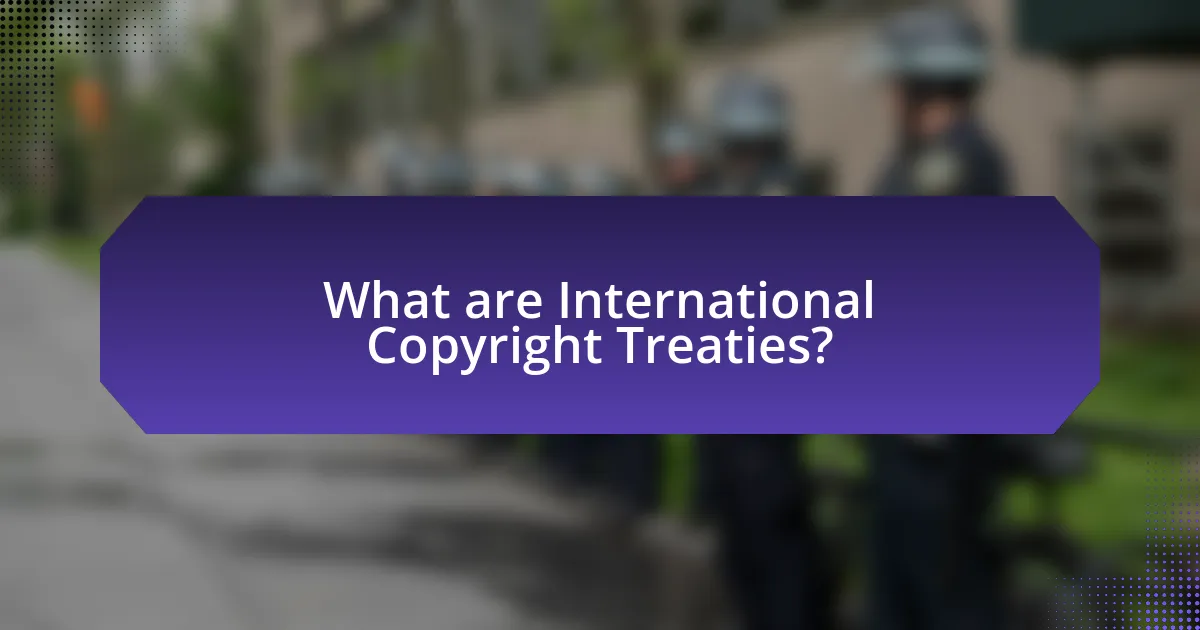International copyright treaties are formal agreements between countries that establish standardized rules for the protection of creative works across borders. This article provides an overview of key treaties such as the Berne Convention and the TRIPS Agreement, detailing their functions, components, and significance in safeguarding creators’ rights globally. It examines how these treaties interact with national laws, their implications for international trade in creative works, and the challenges faced by creators and consumers. Additionally, the article addresses criticisms of current treaties and explores future trends and best practices for creators in navigating international copyright protections.

What are International Copyright Treaties?
International copyright treaties are formal agreements between countries that establish standardized rules for the protection of creative works across borders. These treaties, such as the Berne Convention and the Agreement on Trade-Related Aspects of Intellectual Property Rights (TRIPS), facilitate the recognition and enforcement of copyright laws internationally, ensuring that creators receive protection for their works regardless of where they are used. For instance, the Berne Convention, established in 1886, mandates that member countries recognize the copyright of works from other member states, thereby promoting a unified approach to copyright protection globally.
How do International Copyright Treaties function?
International copyright treaties function by establishing a framework for the protection of creative works across national borders, ensuring that authors and creators receive recognition and compensation for their work globally. These treaties, such as the Berne Convention and the Agreement on Trade-Related Aspects of Intellectual Property Rights (TRIPS), set minimum standards for copyright protection that member countries must adhere to, facilitating mutual recognition of copyright among nations. For instance, the Berne Convention mandates that works created in one member country are automatically protected in all other member countries without the need for formal registration, thus promoting international cooperation in copyright enforcement.
What are the key components of International Copyright Treaties?
The key components of International Copyright Treaties include the protection of authors’ rights, the principle of national treatment, and the establishment of minimum standards for copyright protection. These treaties, such as the Berne Convention and the Agreement on Trade-Related Aspects of Intellectual Property Rights (TRIPS), ensure that creators have exclusive rights to their works and that these rights are recognized across member countries. The principle of national treatment mandates that foreign authors receive the same protection as domestic authors, while minimum standards set by these treaties require countries to provide certain levels of copyright protection, such as the duration of rights and the scope of protected works.
How do these components interact with national laws?
International copyright treaties interact with national laws by establishing a framework that countries must incorporate into their domestic legal systems. These treaties, such as the Berne Convention and the TRIPS Agreement, require member states to provide certain protections for copyrighted works, which national laws must then reflect to ensure compliance. For instance, the Berne Convention mandates that member countries recognize the copyright of works from other member states without the need for formal registration, compelling national laws to align with this principle to facilitate international cooperation and protection of intellectual property rights.
Why are International Copyright Treaties important?
International Copyright Treaties are important because they establish a framework for protecting the rights of creators across different countries. These treaties, such as the Berne Convention and the TRIPS Agreement, facilitate the enforcement of copyright laws internationally, ensuring that authors, musicians, and artists receive recognition and compensation for their work regardless of where it is used. For instance, the Berne Convention mandates that member countries recognize the copyright of works from other member states, which promotes a global standard for copyright protection and helps prevent infringement. This international cooperation is crucial in a digital age where content can be easily shared and accessed across borders, thereby safeguarding the interests of creators worldwide.
What role do they play in protecting creators’ rights?
International copyright treaties play a crucial role in protecting creators’ rights by establishing legal frameworks that safeguard intellectual property across borders. These treaties, such as the Berne Convention and the Agreement on Trade-Related Aspects of Intellectual Property Rights (TRIPS), ensure that creators receive recognition and compensation for their work, regardless of where it is used. For instance, the Berne Convention mandates that member countries provide automatic copyright protection to works created by authors from other member states, thereby reinforcing the rights of creators globally. This international cooperation helps prevent unauthorized use and infringement, ensuring that creators can control the distribution and reproduction of their works.
How do they facilitate international trade in creative works?
International copyright treaties facilitate international trade in creative works by establishing standardized legal frameworks that protect intellectual property rights across borders. These treaties, such as the Berne Convention and the Agreement on Trade-Related Aspects of Intellectual Property Rights (TRIPS), ensure that creators can enforce their rights in foreign markets, thereby encouraging the exchange of creative content. For instance, the Berne Convention mandates that member countries recognize the copyright of works from other member states, which promotes the distribution of literature, music, and art globally. This legal protection fosters confidence among creators and businesses, leading to increased investment in creative industries and broader access to diverse cultural products.

What are the major International Copyright Treaties?
The major international copyright treaties include the Berne Convention for the Protection of Literary and Artistic Works, the Universal Copyright Convention, and the Agreement on Trade-Related Aspects of Intellectual Property Rights (TRIPS). The Berne Convention, established in 1886, sets minimum standards for copyright protection and mandates that member countries recognize the rights of authors from other member states. The Universal Copyright Convention, adopted in 1952, aimed to extend copyright protection to countries that did not join the Berne Convention. TRIPS, established in 1994 as part of the World Trade Organization agreements, sets comprehensive standards for intellectual property protection, including copyright, and requires member countries to adhere to these standards.
What is the Berne Convention?
The Berne Convention is an international agreement that governs copyright protection for literary and artistic works. Established in 1886, it mandates that member countries recognize the copyright of works from other member states without the need for formal registration. The convention ensures that creators have exclusive rights to their works, including reproduction and distribution, and it promotes the principle of “national treatment,” meaning that foreign authors receive the same protection as domestic authors in each member country. As of 2023, the Berne Convention has over 170 member countries, reinforcing its significance in global copyright law.
What are the main principles of the Berne Convention?
The main principles of the Berne Convention include the automatic protection of literary and artistic works, the principle of national treatment, and the requirement for minimum standards of protection. The Berne Convention, established in 1886, ensures that works are protected in all member countries without the need for formal registration. National treatment mandates that foreign authors receive the same rights as domestic authors, promoting equal protection across borders. Additionally, the convention sets minimum standards, such as the duration of copyright protection, which is generally the life of the author plus 50 years, although many countries extend this period. These principles collectively aim to facilitate international cooperation in copyright protection and uphold the rights of creators globally.
How has the Berne Convention evolved over time?
The Berne Convention has evolved significantly since its inception in 1886, adapting to changes in technology and international copyright standards. Initially, the convention established a framework for the protection of literary and artistic works among member countries, requiring a minimum level of protection and the principle of national treatment. Over time, amendments and revisions have expanded its scope, including the 1908 Berlin Revision, which introduced the protection of musical works, and the 1971 Paris Revision, which addressed the rights of authors in the context of reproduction and translation. The most recent significant update occurred in 1996 with the addition of the WIPO Copyright Treaty, which incorporated protections for digital works and addressed the challenges posed by the internet. These changes reflect the ongoing need to balance the rights of creators with the public’s access to cultural and educational resources.
What is the TRIPS Agreement?
The TRIPS Agreement, or the Agreement on Trade-Related Aspects of Intellectual Property Rights, is a comprehensive international legal framework established by the World Trade Organization in 1995. It sets minimum standards for the protection and enforcement of intellectual property rights, including copyrights, trademarks, and patents, across member countries. The TRIPS Agreement aims to harmonize intellectual property laws globally, ensuring that creators and inventors receive adequate protection for their works and innovations, thereby promoting international trade and investment.
What are the key provisions of the TRIPS Agreement?
The key provisions of the TRIPS Agreement include the establishment of minimum standards for the protection of intellectual property rights, including copyrights, trademarks, and patents. Specifically, the agreement mandates that member countries must provide protection for copyrighted works for at least 50 years after the author’s death, ensure that trademarks are protected for an indefinite period as long as they are in use, and grant patent protection for a minimum of 20 years. Additionally, the TRIPS Agreement requires countries to implement effective enforcement measures against intellectual property infringement and to provide mechanisms for dispute resolution. These provisions aim to harmonize intellectual property laws across member states and promote fair competition and innovation in global trade.
How does the TRIPS Agreement impact developing countries?
The TRIPS Agreement impacts developing countries by imposing stricter intellectual property rights standards that can hinder access to essential medicines and technology. Developing nations often face challenges in balancing the enforcement of these rights with the need for affordable healthcare and innovation. For instance, the requirement for patent protection can lead to higher drug prices, limiting access to life-saving treatments. According to a World Health Organization report, countries with stringent patent laws have seen a significant increase in the cost of pharmaceuticals, which disproportionately affects low-income populations. Additionally, the TRIPS Agreement mandates compliance with international standards that may not align with the developmental needs of these countries, potentially stifling local innovation and economic growth.

What are the implications of International Copyright Treaties?
International copyright treaties establish a framework for the protection of creative works across borders, ensuring that authors and creators receive recognition and compensation for their work globally. These treaties, such as the Berne Convention and the TRIPS Agreement, facilitate international cooperation in copyright enforcement, harmonize copyright laws among member countries, and provide a basis for legal recourse against infringement. For instance, the Berne Convention mandates that member countries grant the same rights to foreign authors as they do to their own, which enhances the global market for creative works and encourages cultural exchange.
How do these treaties affect creators and consumers?
International copyright treaties primarily benefit creators by providing legal protections for their intellectual property, which incentivizes creativity and innovation. These treaties, such as the Berne Convention and the TRIPS Agreement, establish minimum standards for copyright protection, ensuring that creators can control the use of their works and receive compensation for their efforts. For consumers, these treaties can lead to a more diverse range of content available legally, as they encourage creators to produce new works knowing they are protected. However, they can also result in restrictions on access to certain works, as enforcement of copyright can limit the availability of content in some regions.
What challenges do creators face under these treaties?
Creators face significant challenges under international copyright treaties, primarily due to the complexity and variability of copyright laws across different jurisdictions. These treaties often create a framework that may not adequately protect creators’ rights in all countries, leading to issues such as enforcement difficulties and varying interpretations of copyright protections. For instance, the Berne Convention mandates minimum standards for copyright protection, but enforcement relies on national laws, which can differ widely. This inconsistency can result in creators being unable to effectively protect their works in foreign markets, leading to potential loss of revenue and control over their intellectual property.
How do consumers benefit from International Copyright Treaties?
Consumers benefit from International Copyright Treaties by gaining access to a wider range of creative works while ensuring that creators are compensated for their efforts. These treaties, such as the Berne Convention and the TRIPS Agreement, establish a framework that protects intellectual property rights across borders, which encourages the production and distribution of diverse content. For instance, consumers can enjoy films, music, and literature from different countries, knowing that the creators receive royalties and recognition for their work. This legal protection fosters innovation and cultural exchange, ultimately enriching the consumer experience.
What are the criticisms of International Copyright Treaties?
International Copyright Treaties face several criticisms, primarily regarding their impact on access to knowledge and cultural expression. Critics argue that these treaties often prioritize the interests of large corporations over individual creators and the public, leading to excessive copyright durations that hinder access to creative works. For instance, the Berne Convention and the TRIPS Agreement have been criticized for enforcing stringent copyright protections that can limit educational and research opportunities, particularly in developing countries. Additionally, the treaties are seen as promoting a one-size-fits-all approach that does not account for the diverse cultural contexts and needs of different nations, potentially stifling local creativity and innovation.
What are the main arguments against current treaties?
The main arguments against current international copyright treaties include their perceived overreach in protecting intellectual property, which can stifle creativity and innovation. Critics argue that these treaties often favor large corporations over individual creators, limiting access to knowledge and cultural works. Additionally, opponents highlight that the enforcement mechanisms can infringe on privacy rights and lead to disproportionate penalties for minor infringements. For instance, the Anti-Counterfeiting Trade Agreement (ACTA) faced backlash for its potential to impose strict enforcement measures that could harm internet freedom and user rights. These arguments are supported by various studies indicating that overly stringent copyright laws can hinder rather than help the creative industries.
How do critics propose to reform these treaties?
Critics propose to reform international copyright treaties by advocating for more flexible copyright terms and stronger exceptions for educational and non-commercial use. They argue that current treaties, such as the Berne Convention and TRIPS Agreement, impose overly restrictive measures that hinder access to knowledge and cultural materials. For instance, critics highlight that the lengthy copyright durations limit public domain access, which could be improved by reducing these terms to a more reasonable timeframe. Additionally, they call for the inclusion of fair use provisions that allow for transformative uses of copyrighted works, thereby fostering creativity and innovation.
What are the future trends in International Copyright Treaties?
Future trends in international copyright treaties include a stronger emphasis on digital rights management, increased harmonization of copyright laws across jurisdictions, and a focus on protecting creators’ rights in the digital economy. The rise of digital content distribution has prompted treaties to adapt, as seen in the 2016 Marrakesh Treaty, which aimed to improve access for visually impaired individuals. Additionally, ongoing discussions in forums like the World Intellectual Property Organization (WIPO) indicate a trend towards addressing challenges posed by artificial intelligence and online platforms, ensuring that copyright frameworks remain relevant in a rapidly evolving technological landscape.
How is technology influencing copyright law globally?
Technology is significantly influencing copyright law globally by necessitating updates to legal frameworks to address digital content distribution and protection. The rise of the internet and digital media has led to challenges in enforcing copyright, prompting countries to adapt their laws to include provisions for online content, such as the Digital Millennium Copyright Act in the United States and the EU Copyright Directive. These adaptations aim to balance the rights of creators with the need for public access to information, reflecting the ongoing evolution of copyright in response to technological advancements.
What potential changes are on the horizon for copyright treaties?
Potential changes on the horizon for copyright treaties include the adaptation of existing frameworks to address digital content and emerging technologies. As the digital landscape evolves, treaties like the Berne Convention and the TRIPS Agreement may undergo revisions to better protect creators’ rights in the context of online distribution and artificial intelligence. For instance, discussions at the World Intellectual Property Organization (WIPO) have highlighted the need for clearer guidelines on copyright in the age of streaming services and social media platforms, reflecting the growing importance of digital rights management. These potential changes aim to balance the interests of creators, consumers, and technology companies, ensuring that copyright laws remain relevant and effective in a rapidly changing environment.
What best practices should creators follow regarding International Copyright Treaties?
Creators should register their works in their home country and consider registration in other countries where they seek protection under international copyright treaties. This practice ensures that creators benefit from the protections afforded by treaties such as the Berne Convention, which mandates that member countries recognize the copyright of works from other member states. Additionally, creators should familiarize themselves with the specific provisions of treaties relevant to their works, as these can vary by jurisdiction. For instance, the World Intellectual Property Organization (WIPO) provides guidelines on copyright laws that can help creators navigate international protections effectively. By adhering to these best practices, creators can safeguard their intellectual property rights across borders.
How can creators effectively protect their works internationally?
Creators can effectively protect their works internationally by utilizing international copyright treaties such as the Berne Convention and the Agreement on Trade-Related Aspects of Intellectual Property Rights (TRIPS). These treaties establish a framework for copyright protection that obligates member countries to recognize and enforce copyright laws of other member states, ensuring that creators’ rights are upheld across borders. For instance, the Berne Convention mandates that works originating in one member country receive the same protection in all other member countries, which significantly enhances the ability of creators to safeguard their intellectual property globally.
What resources are available for understanding copyright treaties?
Resources available for understanding copyright treaties include official documents from international organizations, academic articles, and legal textbooks. The World Intellectual Property Organization (WIPO) provides comprehensive resources, including treaties like the Berne Convention and the TRIPS Agreement, which outline copyright protections globally. Additionally, scholarly articles in journals such as the “Journal of Intellectual Property Law & Practice” offer in-depth analyses of treaty implications. Legal textbooks, such as “Copyright Law: Essential Cases and Materials” by Robert A. Gorman and Jane C. Ginsburg, provide foundational knowledge and case studies related to copyright treaties. These resources collectively enhance understanding of the complexities and applications of copyright law on an international scale.



